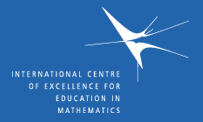
The University of Sydney
15 January – 9 February 2007
Wavelets and Computation
- Duration
- Four Weeks
- Lecturer
- Markus Hegland (Australian National University)
- Consultation Hours
- By appointment, contact the lecturer.
- Assessment
- Assignments, project and exam, roughly half for the project and half for the assignments and exam. For more detail see http://wwwmaths.anu.edu.au/~hegland/amsi07/.
- Assumed Knowledge
- The course should be accessible and of interest to students doing mathematics, science, computer science and engineering who have done one to two years of advanced calculus and linear algebra. Familiarity with concepts like continuity, differentiability, convergence, and Taylor series is assumed both for one and multidimensional functions. From linear algebra we will need vector spaces and linear mappings, orthogonality and eigenvalues. Some familiarity with Lebesgue measures, Hilbert spaces and Fourier series and transforms is an advantage but results from these areas will be reviewed during the course.
- Background Material
- Revise the material as covered in a good analysis book like W. Rudin: Principles
of Mathematical Analysis or a calculus book like R. A. Adams: Calculus – A Complete Course.
Most of the material covered in the course can be found in: S. Mallat, A Wavelet Tour of Signal Processing.
There is a vast amount of literature on wavelets, a reference from the early days of wavelets (15 years ago) is I. Daubechies: Ten Lectures on Wavelets. This book is for the mathematically inclined reader, a more computational reader may enjoy: Wavelets and Filter Banks by Gilbert Strang and Truong Nguyen. A very readable introduction by one of the pioneers of wavelet research in the 80s is: Wavelets: Algorithms & Applications by Yves Meyer. Other references will be provided throughout the course.
- Resources
- Lecture notes and other supporting material will be posted at http://wwwmaths.anu.edu.au/~hegland/amsi07/.
- Course Outline
- The course provides an introduction to wavelets, with a particular focus on
computational aspects including approximation and numerical linear algebra. During the
course, the mathematical foundations and concepts required for time-frequency analysis and
multi-resolution will be extensively discussed.
The course has three main themes: In the first weeks, we discuss Fourier analysis, from convolutions to the Heisenberg uncertainty. This is followed by a discussion of discrete Fourier transforms, windowed transforms up to the fast Fourier transform (FFT). The second theme are the actual wavelets. After an introduction to time/frequency analysis we will discuss connections between regularity and the size of the wavelet transform, vanishing moments and multi-resolution. The third theme is computational. Here we cover particular wavelet basis followed by an introduction to approximation theory using Fourier analysis and Sobolev spaces for the linear case and Besov spaces for the nonlinear case. If there is time at the end we will review applications of wavelets to machine learning, image processing and compression. Furthermore, we will consider the implementation of the fast wavelet transform and applications in high-dimensional approximation.
The course consists of lectures and tutorials where the students will be able to actively explore either given topics or questions they are interested in which relate to the course. The ratio of lectures to tutorials is around 3:1 but can vary depending on the interests and backgrounds of the participants.